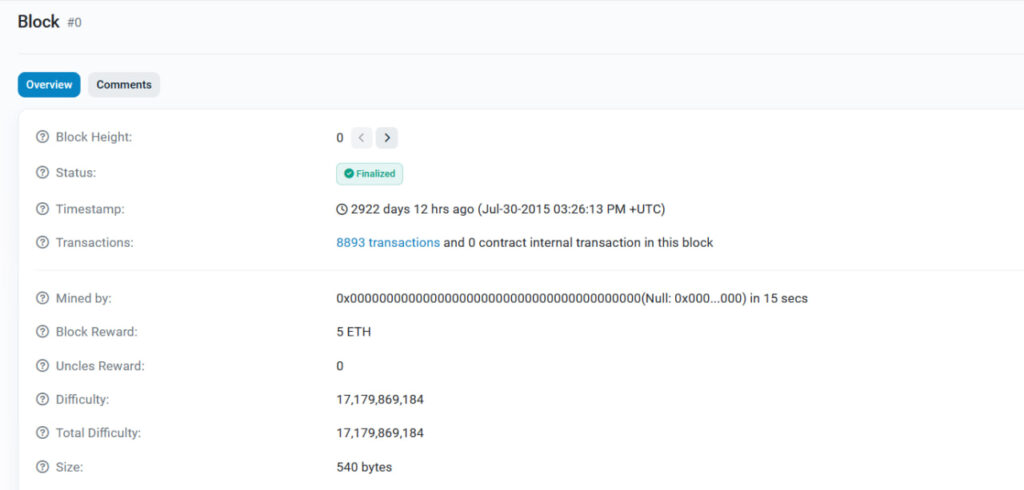
On Sunday, July 30, it was 8 years since the Ethereum Foundation announced the launch of the Ethereum blockchain.
Ethereum’s genesis block, the network’s first block, occurred on July 30, 2015, at 03:26 pm +UTC. According to data from Etherscan, this block contained 8.893 transactions, was 540 bytes in size, and generated a block reward of 5 ETH, paid to network miners at the time.
Although Ethereum has changed a lot today, the creation of this first block marked a milestone, giving rise to one of the most important blockchains in the crypto industry.

Source: Etherscan
The launch of Ethereum was announced by Stephen Taul, former CCO of the Ethereum Foundation. On the Foundation's blog, Taul wrote that the network's genesis block had been uploaded and the Ethereum blockchain was live.
With these message, the Foundation’s former CCO confirmed to the community that the blockchain network that had been in the works for the past year and a half had become a reality. Today, Ethereum is the second-largest cryptocurrency and blockchain network by market capitalization, currently valued at $225.700 billion.
The blockchain that made smart contracts a reality
Ethereum was created from Vitalik Buterin’s vision of creating a censorship-proof “world computer” that would allow for decentralized operations.
Unlike Bitcoin, the Ethereum network has the ability to natively create and use smart contracts and new tokens, which has made it easier to run decentralized applications and allowed the construction of one of the largest and most revolutionary ecosystems in the crypto/blockchain industry.

Although the concept of smart contract is attributed to Nick Szabo, who first mentioned the term in 1995, the arrival of blockchain technology has made it possible to create this new type of computer contract, as highlighted by the consultancy firm specialising in data protection, Grupo Atico34.
In addition to Buterin, Gavin Woods and Greg Colvin also played a key role in the development of Ethereum.
Ethereum Virtual Machine (EVM)
Ethereum makes use of a virtual machine, the Ethereum Virtual Machine, EVM for its acronym in English, which executes a large number of instructions to allow the network to run decentralized applications (DdApps).
The EVM is based on the Solidity programming language and is currently one of the key pieces in the design of Ethereum, representing the heart of this blockchain.
From Proof of Work to Proof of Stake
Although Ethereum began development from day 1 to run dApps, the blockchain was not ready for mass use. The development of hundreds of decentralized applications and their high demand and use have led Ethereum to face major scalability problems in recent years, which have slowed down the network and raised its commission rates to stratospheric levels.
To solve these problems, Ethereum has been incorporating scalability solutions such as layer 2 (L2) networks. However, the blockchain network has also undergone one of the most significant changes in the blockchain industry, which has been the variation of the consensus protocol.
To increase its scalability, Ethereum set out to transform itself into a new network, migrating its protocol from the Proof of Work (PoW) consensus model to the Proof of Stake (PoS) consensus model, a feat that would make it more scalable, secure, and efficient. Thus, in December 2020, the genesis block of the new network was produced, known at that time as Ethereum 2.0 to differentiate it from the PoW network.
The transformation of Ethereum completed on September 15, 2022, becoming a completely PoS blockchain.
Continue reading: The Ethereum network accumulates $1.300 billion in fees paid per day this year



